Innocence and Vulnerability Part II
INTRODUCTION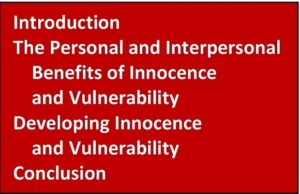
In the November 2022 Letter we defined innocence and vulnerability. Innocence is experiencing things for the first time and responding spontaneously to the experience. Children are automatically innocent because of their lack of experience. As an adult innocence is having new experiences or approaching other experiences as if we are experiencing them for the first time. Vulnerability is being open and unguarded as we approach experience, both external and internal experiences. Vulnerability is a boundary issue concerning the boundaries between ourselves and other people and between internal aspects of ourself. A boundary is a barrier. An open boundary lets things pass into our self and into our awareness when we are relaxed and unguarded. A closed boundary blocks entrance. (Please read the November 2022 issue for more information about the definitions of innocence and vulnerability.) [i]
In the November Letter we described the personal benefits of innocence and vulnerability. In this Letter we turn our attention to the interpersonal benefits of innocence and vulnerability. We will also focus on practical ways to bring them into our lives.
Point of Empowerment: Innocence and vulnerability can be a daily part of our life and can make profound contributions to the satisfaction that we experience in life.
THE PERSONAL AND INTERPERSONAL BENEFITS OF INNOCENCE AND VULNERABILTIY
Intimacy
Intimacy is a benefit of vulnerability. And without vulnerability intimacy is not possible. Intimacy is one of the great rewards of living. In the November Letter we discussed intimacy with oneself in the form of getting to know yourself and having access to all the parts of yourself for full living. Intimacy is close contact, “up close and personal.” Close contact with ourself brings awareness of our thoughts and feelings, sometimes awareness of intense and frightening feelings. Intimacy as close contact with ourself brings recognition and clear perceptions of what we see, hear, touch, taste, smell, and feel. What we see, hear, touch, taste, smell, and feel is the “now” of experience. To bring awareness to all of our perceptions requires the open boundaries of vulnerability, allowing it all in.
Intimacy with other people furthers the kind of connection that human beings need in order to feel human. It creates the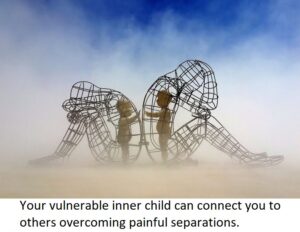 closeness that stimulates feeling alive and fulfills our need to belong. Intimacy can lead to love and love can lead to intimacy as the two are linked together. We want and seek intimacy. At the same time we fear intimacy because we fear vulnerability. We fear vulnerability because we are afraid of getting hurt.
closeness that stimulates feeling alive and fulfills our need to belong. Intimacy can lead to love and love can lead to intimacy as the two are linked together. We want and seek intimacy. At the same time we fear intimacy because we fear vulnerability. We fear vulnerability because we are afraid of getting hurt.
Point of Empowerment: We make our life enjoyable and fulfilling by having intimacy with others. Some people feel an unbearable longing for intimacy if it is missing from their life.
To be intimate with other people is to be vulnerable, to let them in past our boundaries. We relax and say, “Yes come closer.” We share thoughts, feelings, and physical space. The other person gets to know who we are. This includes our weaknesses, where we can be hurt. As we relax our boundaries, let someone pass through and get to know us, they now have the capacity to hurt us if that is their choice.
To be vulnerable and intimate, trust and commitment are necessary. With trust we say, “I know that you will not intentionally hurt me. If you unintentionally hurt me you will take responsibility for your behavior and do your best not to hurt me again. We are committed to our relationship. We have a commitment that promises to sustain us during times of intentional or unintentional hurt.” In order to be vulnerable we must be willing to risk getting hurt. To take this risk we need to feel confident that we are able to tolerate, manage, and heal hurt so hurt does not scare us. Otherwise our fear of getting hurt will cause us to avoid vulnerability and intimacy.
Love
Vulnerability, as an open boundary, is necessary for love because love involves giving and receiving. In love we act in a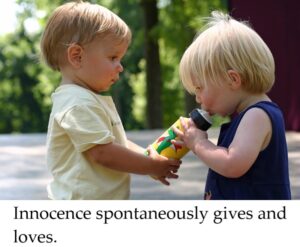 loving manner. We give of ourselves which means opening up to what is loving within us and taking the actions that project that love into the outside world. Love is being intimate with ourself. Some examples of loving actions: we give of ourself by paying attention to our loved one. We see what he or she needs and give it to them. If he is sad we give him a hug. If she is angry we respect her anger by listening to what that anger is about. If he or she is happy we seek to share that happiness. We hold our loved one dear by recognizing what he or she means to us. This recognition is a form of loving respect.
loving manner. We give of ourselves which means opening up to what is loving within us and taking the actions that project that love into the outside world. Love is being intimate with ourself. Some examples of loving actions: we give of ourself by paying attention to our loved one. We see what he or she needs and give it to them. If he is sad we give him a hug. If she is angry we respect her anger by listening to what that anger is about. If he or she is happy we seek to share that happiness. We hold our loved one dear by recognizing what he or she means to us. This recognition is a form of loving respect.
As we act in a loving way we express our feelings of love. The other person then experiences feeling loved because they have perceived, allowed, and received our feeling. If our boundary is closed we will not express our loving feelings. If the other person’s boundary is closed they will not feel loved because they have not let our expression of feeling in and felt it. In feeling our loving feelings the other person is vulnerable with themselves, intimate with their own feelings.
Point of Empowerment: Without vulnerability there is no love. To the degree that we are vulnerable is the degree that we can give and receive love.
Point of Empowerment: Giving love is putting forth the love that is inside you. The more vulnerable and intimate we are with ourselves, the more love we can find within ourself. The supply of love has no limits.
New
With innocence we can experience our intimates, our loved ones, as new each day. They may or may not be “new” but in seeing them as potentially new we create the possibility and space for them to change and to grow. By looking for and focusing on what is new in others and in our life we create more opportunities for positive growth. For example: our loved one tells us about an experience they had. We ask them about the details of the experience looking for what is new in that experience. We ask a question about the new aspects and help the other person to focus on and tell us about these aspects. As they tell us about them, they are experiencing what is new for themselves. This focus provides them with the opportunity for growth.
Point of Empowerment: We are carried by the river of life. Since the river is always changing, we are always changing in response to it. Since the river is different each day, we are different each day.
Charming
Innocence and vulnerability are often experienced as charming. We are drawn to people who exhibit innocence and vulnerability. Innocence and vulnerability seem to touch our heart. We often (but not always), respond with curiosity and protectiveness toward the other person. We also can respond to innocence and vulnerability with ourself with curiosity and protectiveness. Recognizing innocence and vulnerability in our self and in others will bring us pleasure.
In addition, we need to be innocent and vulnerable with the right people. Some people will find it charming but others may see it as weakness and foolishness and see an opportunity to view us with contempt and to ridicule us. Being vulnerable with someone you cannot trust is foolish and setting yourself up to be hurt. Some people repeatedly set themselves up to be hurt.
Point of Empowerment: Our discussion of the benefits of innocence and vulnerability shows us that being able to use innocence and vulnerability is a strength that we can use to improve the quality of our relationships with others and to improve the quality of our life.
DEVELOPING INNOCENCE AND VULNERABILITY
Here are ways to develop innocence and vulnerability, ways to bring them into our lives.
Innocence
As adults, to bring innocence into our life, we can notice when our experiences are new. We open ourself to this recognition by focusing our attention on newness and allowing that newness into our awareness. Next we can pretend that we are experiencing things for the first time, approaching our experiences as if they are new. If we pretend and act as if we are not fooling ourself but trying on a new approach that we may discover we like. We can discard acting as if and pretending if these approaches don’t bring the new into our life. Pretending and acting as if comes to us naturally and automatically at times. For example, if we don’t like what a person has cooked we may pretend and act as if we do like it so as not to hurt her or his hurt feelings. We can approach upcoming events with excitement and eyes wide open seeing the details of the event as potentially new. Actually we “look forward” to the future hoping that it will bring us something new. Approaching the movies, a concert, or a visit with friends or family can present something new to us if we are looking for it.
Finally, we can block our tendency to fit the present into the past because we are more comfortable with repetition than with novelty. We try not to take our life for granted by assuming that the past will automatically repeat itself in the future. Actually, each experience is new because we are new each day of our life. If we look at ourselves very carefully we will see that we are not the same today as we were yesterday, though the changes may be very small and hard to see.
Practice: Each morning ask yourself, “What new and exciting experiences are going to happen today?” State the affirmation, “I now focus my attention on the new in my life and approach my life with innocence.”
To develop innocence we need to have the willingness and determination to reorient the way we perceive ourselves and the world. We have said that innocence includes spontaneous behavior. We need to be willing to take the risk of being spontaneous, the risk that some spontaneous behavior can result in getting it right some of the time and in making mistakes at other times. If we believe that it is ok to make mistakes, that mistakes can be forgiven, and can be seen as opportunities to learn, we can relax into spontaneous behavior. We won’t fear spontaneous behavior because we don’t fear mistakes.
Practice: Write down your beliefs about mistakes. Review and change them by stating affirmations about your new beliefs. Put those beliefs into practice. For example, state, “I now believe that it is ok to make mistakes.” Be aware of making mistakes and state the affirmation when you notice one. (This very powerful process can be used to change any belief and any behavior that follows that belief.)
Practice: Spontaneous behavior is a quick reaction to a stimulus, to something that has happened. It is sometimes called impulsive behavior. Practice spontaneous action by allowing yourself to react quickly without censorship or inhibition. Contrast that to deliberate action where you think before reacting. Both spontaneous and deliberate behavior are necessary for the art of living.
Vulnerability
To develop vulnerability:
- Know and experience the benefits and the pleasure that comes with vulnerability (and innocence). This provides the motivation to develop the abilities necessary to be vulnerable and innocent.
- Learn how to use your boundaries, how to open or close them or to have them be partially open or closed as appropriate. This learning is challenging and is a lifelong process but we can make great progress along the way.
- To work with your boundaries start with working with your feelings. They are the first pieces of information we have about when to open and close our boundaries.
- Allow yourself to feel and know what you are feeling. Relax into your feeling trying to avoid tensing your body and avoid the inner tension of being afraid of your feelings. Fear creates tension.
- Know why you feel as you do and interpret the message that a feeling has for you. Examine the situation you are reacting to relying on your ability to connect feelings with situations. Listen for the messages from your feelings that you will get if you look for them.
- Act on the messages of your feelings. Painful feelings are messages to close and set boundaries. Pleasurable feelings are messages to relax and open boundaries. For example, if spending time with a friend is unpleasant or painful or lacks the opportunity to be vulnerable, you could consider saying no to an invitation to be with this person. Regarding pleasure, kissing another person can bring us pleasure. As you kiss look for and become aware of the physical and emotional pleasure. Relaxing into the pleasure opens your boundary. If you notice tension while kissing relax that tension. This may not be easy if there are fears present. Work with your fears.
Point of Empowerment: Remember that human beings have rights. Assert your right to protect yourself by saying no and closing your boundaries. We also have the right to experience pleasure. Assert that right by saying “yes come in” when you encounter pleasure.
Point of Empowerment: Appreciate your feelings as crucial tools for living a rewarding life.
Practice: Tense your muscles feeling the power and determination that can be present. This is the power and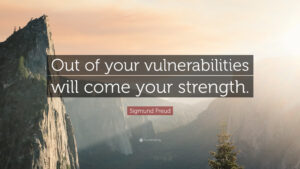 determination to say no when you want to. Relax your muscles sensing the openness that you have created, the open boundary that says yes come in.
determination to say no when you want to. Relax your muscles sensing the openness that you have created, the open boundary that says yes come in.
- Develop the courage to be vulnerable by having the confidence that comes with knowing how to use your boundaries, knowing that you will be safe. Notice when courage and confidence are present or when there is the fear that causes us to shut down closing us off from the world that is around us.
- Develop the courage to be vulnerable with yourself, the courage to face the unknown of yourself. Courage is being willing to take beneficial risks. In being vulnerable, courage is necessary to take the risk that we may discover something about ourself that we don’t like. This courage comes from seeing and wanting the benefits of vulnerability and innocence.
- Develop vulnerability with the self-acceptance that enables you to meet the “unacceptable” parts of yourself, the parts that you are not proud of. Self-acceptance says, “It is ok to have parts of myself that I am not proud of because I am a fallible human being and a work in progress.”
- Develop self-acceptance by developing self-esteem and self-worth. Good feelings about ourself—self-esteem, comes from seeing the good that we do and giving ourselves credit for these actions. Self-worth comes from recognizing the innate (what we are born with) value and worth that comes with being a human being. People have an innate worth that does not have to be earned and cannot be taken away.
Practice: Work with the attitude of “I don’t know,” as a statement of innocence and vulnerability. “I don’t know” opens you to seeing things as new, to the unknown, and to creativity. “I don’t know” could be criticized by another person or by yourself. As you say, “I don’t know,” feel the innocence, vulnerability, and excitement that can be present.
CONCLUSION
We have presented some ideas about developing innocence and vulnerability. Developing them is not easy and is a challenging process. But the rewards of this process are the benefits of innocence and vulnerability. Think of yourself as a “work in progress” that takes years to complete. See yourself on an exciting journey. In the March Letter we will explore the resistance to developing innocence and vulnerability and discuss practical ways to overcome this resistance.
[i] Nov 2022 Letter | International Institute for Self Development (iifsd.org)
